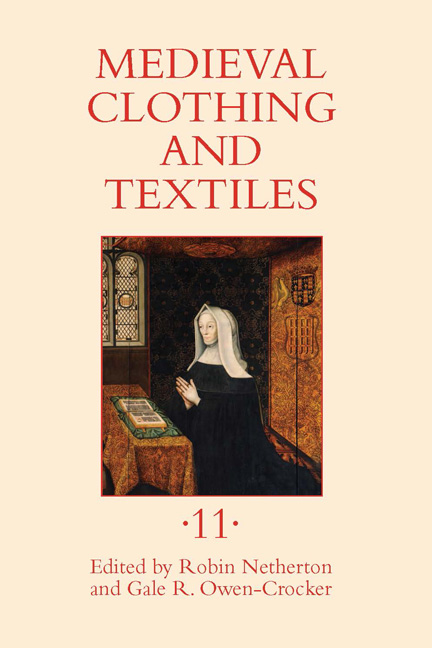Book contents
- Frontmatter
- Contents
- Illustrations
- Tables
- Contributors
- Preface
- 1 Production, Quality, and Social Status in Viking Age Dress: Three Cases from Western Norway
- 2 The Effect of Spindle Whorl Design on Wool Thread Production: A Practical Experiment Based on Examples from Eighth-Century Denmark
- 3 The Shirt Attributed to St. Louis
- 4 Angevin-Sicilian Sumptuary Statutes of the 1290s: Fashion in the Thirteenth-Century Mediterranean
- 5 The Devil on My Tail: Clothing and Visual Culture in the Camposanto Last Judgment
- 6 “Transposing þe shapus þat God first mad them of”: Manipulated Masculinity in the Galaunt Tradition
- 7 Textiles and Dress in the Household Papers of Lady Margaret Beaufort (1443–1509), Mother of King Henry VII
- 8 “Like two artificial gods”: Needlework and Female Bonding in A Midsummer Night's Dream
- Recent Books of Interest
- Contents of Previous Volumes
6 - “Transposing þe shapus þat God first mad them of”: Manipulated Masculinity in the Galaunt Tradition
Published online by Cambridge University Press: 05 December 2015
- Frontmatter
- Contents
- Illustrations
- Tables
- Contributors
- Preface
- 1 Production, Quality, and Social Status in Viking Age Dress: Three Cases from Western Norway
- 2 The Effect of Spindle Whorl Design on Wool Thread Production: A Practical Experiment Based on Examples from Eighth-Century Denmark
- 3 The Shirt Attributed to St. Louis
- 4 Angevin-Sicilian Sumptuary Statutes of the 1290s: Fashion in the Thirteenth-Century Mediterranean
- 5 The Devil on My Tail: Clothing and Visual Culture in the Camposanto Last Judgment
- 6 “Transposing þe shapus þat God first mad them of”: Manipulated Masculinity in the Galaunt Tradition
- 7 Textiles and Dress in the Household Papers of Lady Margaret Beaufort (1443–1509), Mother of King Henry VII
- 8 “Like two artificial gods”: Needlework and Female Bonding in A Midsummer Night's Dream
- Recent Books of Interest
- Contents of Previous Volumes
Summary
Whilst in modern parlance the term “gallant” has come to be associated with chivalric virtues and courteous behaviour, it was first used, in Middle English, to describe a stereotype of fashionably dressed young men synonymous with licentiousness and delinquency. The galaunt figure is extremely prevalent in the literature of late medieval England. It is referred to in a variety of literary sources, from verse satire to drama, and is even mentioned in material as disparate as personal letters, legal cases, and guild accounts. The earliest extant description of the galaunt that refers to the figure by name can be found in the late-fourteenth-century satirical lyric catalogued in the Digital Index of Middle English Verse (DIMEV) as no. 4853, a macaronic complaint that bemoans the lasciviousness of contemporary society. Between the composition of this text and the end of the fifteenth century, the figure features in at least thirty-six additional examples and becomes, in the words of Fiona Dunlop, “the most frequently mentioned inappropriate identity” of this period.
This article will explore the concerns expressed in this large body of literature about the transformative effects of the galaunt's fashions, which will be shown to have been consistently viewed as being both physically and spiritually distortive. Through its investigation of these criticisms about the manipulative effects of the figure's clothing, the article will bring to light the anxieties about forged masculine authority and effeminacy that inform the sartorial discourses exercised in the tradition.
LITERARY ANALYSIS OF THE GALAUNT FIGURE
Despite the cultural significance of the late medieval galaunt tradition, it has received little, though some excellent, scholarly attention. John Scattergood wrote about the figure in 1971, including a brief discussion of some of the galaunt texts and their interaction with contemporary sociopolitical factors, in his monograph Politics and Poetry in the Fifteenth Century. Scattergood's interest in the figure also resulted in the publication of a note in 1974 on the dress of the character Ryotte (that is, “riot”) in John Skelton's poem The Bowge of Courte and how those costume features related to the wider galaunt tradition.
- Type
- Chapter
- Information
- Medieval Clothing and Textiles 11 , pp. 119 - 138Publisher: Boydell & BrewerPrint publication year: 2015



